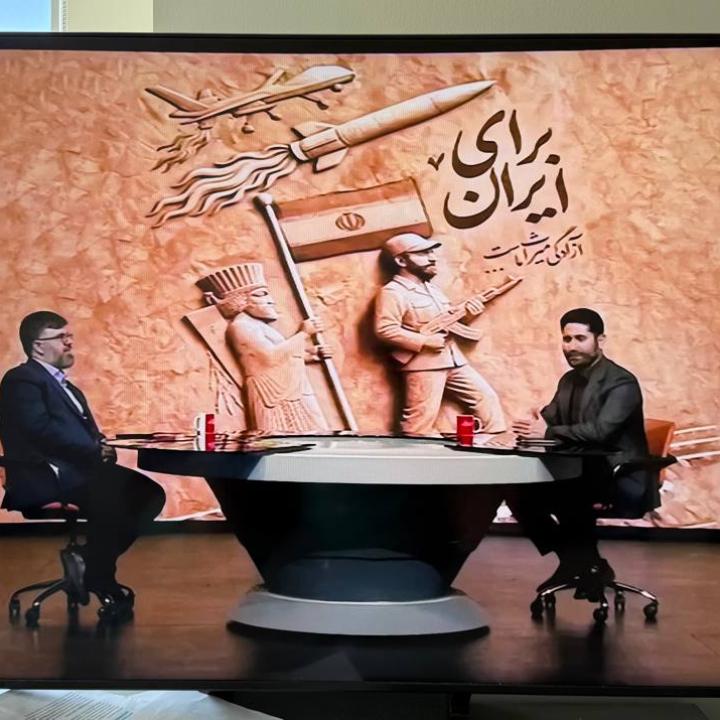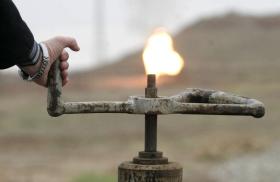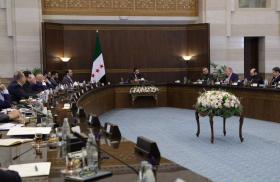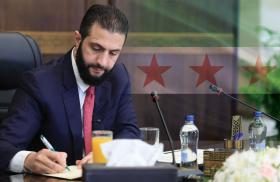
- Policy Analysis
- PolicyWatch 4114
Iranians Are Not Rallying Behind the Islamic Republic

The regime’s attempts to stir up nationalist support and increase its legitimacy postwar are not working—opposition is at a historical high.
What is now the largest bronze statue in Iran was unveiled on July 27 in Tehran’s Vanak Square—a nearly fifty-foot figure of Arash the Archer, an ancient Persian folklore figure who became a symbol of the recent twelve-day war with Israel. According to legend, Arash shoots an arrow whose landing place will determine the border between Iran and Turan, but he dies from the effort, sacrificing his life to end a war and secure the nation’s survival. Previously invoked on billboards, a tweet by President Masoud Pezeshkian, and elsewhere, such imagery is meant to tug at Iranians’ heartstrings and retrofit pre-Islamic history to shore up legitimacy amid historically high anti-regime sentiment. Most Iranians are not buying it, though.
To sell the narrative, state media has featured programs that use ancient Persian motifs. One segment during the war showed a relief of an Achaemenid soldier from Persepolis holding an Islamic Republic flag alongside a modern soldier, with a backdrop reading “Baraye Iran” (For the Sake of Iran). That phrase was a play on Shervin Hajipour’s Grammy-award-winning song “Baraye,” the de facto anthem of the 2022 “Woman, Life, Freedom” uprising, which sought an end to the clerical establishment and was later appropriated as a campaign slogan for Pezeshkian. When the ceasefire with Israel was declared on June 24, the pre-revolution de facto national anthem “Ey Iran” (Oh Iran) was performed on numerous occasions (albeit with some lyric changes), including in the iconic Azadi Square—ground zero for past mass movements like the anti-Shah demonstrations of 1979 and the 2009 Green Movement.
Strikingly, these images appeared during Muharram, the holy month when Shia Muslims commemorate the martyrdom of the Prophet Muhammad’s grandson at the Battle of Karbala—a popular regime symbol used to mobilize Iranians against “Western imperialism.” Pre-Islamic Iran was also invoked in Supreme Leader Ali Khamenei’s first speech after the war ended, which marked Muharram with a tone that was more Iranian than Islamic. Across the country, eulogists lamenting Imam Hussein’s martyrdom wove nationalistic poems and themes into some of their lyrics. That projection has continued more recently, with Pezeshkian appearing at the UN General Assembly in New York wearing an Iran-shaped lapel pin.
This trend predates the war. Since the early 2000s, the Islamic Republic has experimented with unconventional means to win hearts and minds, such as staging a theatrical production of the ancient epic Shahnameh and using underground rapper Amir Tataloo to sing the regime mantra “Nuclear energy is our inherent right.” (Ironically, Tataloo was later imprisoned and is currently facing a death sentence.) While the regime is, at its core, Islamic, it has been making a faux transition to become more nationalistic and arguably more Iranian in order to secure the dwindling support of its people. The war accelerated this desperate attempt, driven by the reality that an estimated 80 percent of Iranians oppose the clerical establishment and want it gone.
Historically, Iranians have embraced nationalism, viewing the bloody eight-year Iran-Iraq War, for example, as a “righteous reenactment of the Battle of Karbala.” Yet today, they are mostly divided on the Islamic Republic’s nuclear nationalism. Nearly a generation after Tehran began enriching uranium domestically in 2006, many associate the nuclear program with economic isolation and misery, due to mismanagement, corruption, and, in part, the brief benefits of the 2015 nuclear deal, which were cut short by the U.S. withdrawal from the agreement in 2018.
The recent war changed some of that thinking. Some Iranians—mostly core regime supporters and those on a nationalistic high because a foreign enemy invaded their country—argued that if Tehran had developed a nuclear weapon, it would have deterred the Israeli (and American) attacks. Such sentiment predates the war, when some argued that Iran should go “all the way” with its nuclear program since it abided by the 2015 deal and was sanctioned nevertheless.
But the war also provided anti-regime Iranians with the stark realization that their country lacked air raid sirens and shelters, and that the clerical establishment’s foreign policy—arming and funding proxies abroad, calling for Israel’s destruction, and developing a nuclear program—brought war to their doorstep. They certainly did not wish to see their country destroyed by the war—which led to the deaths of 1,190 Iranians, at least 436 of whom have been identified as civilians—but they did not view the clerical establishment as their protector. In essence, they rallied around the soil of Iran, not the flag of the Islamic Republic. As researcher Hossein Dehbashi noted, “It is a great mistake if the higher-ups think that the empathy and unity of the people of Iran against a foreign enemy equates to their satisfaction with the Islamic Republic.”
Now that the fog of war has dissipated, many Iranians are concluding that their biggest problems were homegrown: the systemic mismanagement, corruption, and repression that have persisted for forty-six years. More than three months after the ceasefire, Iranians are living with unprecedented power outages and water shortages that disrupt their daily lives. For some, the outages are nuisances that interrupt household chores, trap people in elevators, or even force surgeons to conduct surgery by flashlight. For the average Iranian, however, it is much more, as they struggle to make ends meet in a rotten economy. Much of their food spoils, and the many electronics and appliances that burn out because of power surges are expensive to replace due to rampant inflation and an effectively worthless rial. In response, authorities have ordered office and school closures to alleviate the strain on the power grid—a damning sign in a country that ranks second in global natural gas reserves and fourth in oil reserves.
The water situation is even more dire, as the country faces its fifth consecutive year of drought from decades of poor water management, exacerbated by climate change. Those who can afford it are relying on water pumps, but environmentalists and even regime officials warn that the capital may run out of water within weeks.
Since the war, protests have erupted in numerous parts of the country, including in southwest Fars province, where past strikes were key to the 1979 revolution. Angry that their money is being spent on foreign proxies, protesters chant “No Gaza, no Lebanon, my life for Iran,” and “Leave Palestine, think of us.” Many also call for “freedom, freedom, freedom” and “Death to Khamenei.” These chants, common for years, have been updated to include “water, electricity, life are our inherent rights”—a pointed twist on the nuclear slogan of nearly two decades ago. As the clerical establishment sought to co-opt “Ey Iran,” protesters have sung the anthem as well—highlighting the question of who embodies true nationalism: the Islamic Republic or those who dare to oppose it?
As the regime projects a false image of unity, it is simultaneously “waging a terrifying crackdown,” according to human rights organizations, with some 21,000 “suspects” arrested and more than 1,000 executed since January—the highest rate in fifteen years. In addition, over half a million Afghan refugees have been expelled since June on allegations that they are working with Israel’s Mossad. Authorities even filed charges against a comedian after she poked fun at the author of the Shahnameh, apparently to stir up nationalist sentiment.
During Muharram, photos and videos of Gen Z women mingling without the mandatory hijab went viral, prompting criticism that authorities had staged the scenes to project the image of easing restrictions. In reality, activists were reporting a “disastrous” crackdown on women. Signs of defiance have become familiar in much of the country since 2022, despite threats of arrest, hefty fines, and the passage of a draconian hijab law. But as women’s rights activist Zeinab Zaman argued in response to the viral photos, “The presence of women without hijab in the city is the result of years of struggle, courage, and resistance by women to have the right to choose their clothing, and it continues.”
Elsewhere, news broke in early September that classical singer Homayoun Shajarian had surprisingly received a permit to perform at Azadi Square. The free concert was controversial, with critics accusing him of being a regime pawn and whitewashing the 2022 uprising, whose anniversary fell on September 16. Within days, Shajarian announced the cancellation of the historic concert, citing as one of the reasons a lack of “management to handle a crowd of millions”—which many suspect masked fears of anti-regime protests breaking out at the performance.
In the political realm, the Reformist Front, a reformist umbrella organization with twenty-seven factions, issued a statement outlining a roadmap for domestic and foreign policy changes—a conversation that many Iranians would have welcomed years ago but are skeptical of today. Among the group’s proposals was a total suspension of uranium enrichment; the release of all political prisoners; changes to laws related to women’s rights; and a ban on the Islamic Revolutionary Guard Corps (IRGC) participating in politics—measures that would fundamentally transform the Islamic Republic. These led to condemnation from the Supreme Leader’s mouthpiece, the hardline newspaper Kayhan.
More important, however, the 2022 uprising indicated that many Iranians have lost trust in the clerical establishment altogether—a sentiment exacerbated by reformists’ repeated failure to deliver on promises of expanded civil liberties and other changes over the decades. This deterioration was underscored by last year’s presidential and parliamentary elections, which recorded the lowest turnouts in the Islamic Republic’s history.
This August, seventeen political and civil rights activists signed a statement calling for a referendum and the establishment of a constitutional assembly. As signatory Narges Mohammadi, a Nobel laureate, explained, “The Islamic Republic as a religious authoritarian government has shown that it cannot be reformed.” Similar comments were made in July by former Green Movement leader Mir Hossein Mousavi (a reformist who has been under house arrest since 2011) and were endorsed by seven hundred activists.
Meanwhile, the August initiation of the thirty-day snapback process for UN sanctions sent the rial to historic lows against the U.S. dollar, further eroding Iranians’ purchasing power, which has continued since snapback was reimposed. Rather than directing their anger at the West, however, the Free Union of Iranian Workers declared, “We, the workers, retirees, wage earners and oppressed layers of society, know you very well and will not allow you to deceive us with excuses like wars, sanctions, and the very inflation you yourselves have created.” Similar sentiments rang out in Kermanshah on September 21, when retirees chanted, “Our enemy is right here, they lie when they say it’s in America,” and “Enough warmongering, our tables are empty.”
Most Iranians also expect that another war with Israel is inevitable, while the clerical establishment appears to be rebuilding what is left of its ballistic missile sites and increasing construction at one of its nuclear facilities. The signs of preparation for another showdown are there: continuing military drills; the reconstitution of the National Defense Council, which has not existed since the war with Iraq, to prepare defensive measures for future conflicts; and the fact that the Iranian army is collecting wills from military personnel and planning to distribute dog tags. Yet as Ali Ansari, director of the Institute for Iranian Studies at the University of St. Andrews, told the author, “The idea that Iran is ready for another war with Israel when it is literally running out of water is farcical. It’s deck chairs on the Titanic.”
Indeed, the Islamic Republic has never looked more fragile, and the country’s future is now largely up for grabs—shaped by Israeli and U.S. pressure, the eventual post-Khamenei succession, the actions of the IRGC, or some combination of these factors. “The Islamic Republic as a political system,” said Ansari, “is dying a death by a thousand cuts, any one of which could prove fatal.” In recent weeks, memes and videos of the Titanic have gone viral among Iranians, a reflection of the widening view that the Islamic Republic is taking on water.
Holly Dagres is the Libitzky Family Senior Fellow at The Washington Institute and the curator of The Iranist newsletter.



